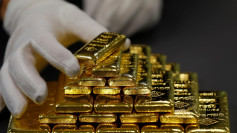The Federal Reserve left its benchmark interest rate unchanged Wednesday for the fourth consecutive meeting, maintaining the range at 4.25% to 4.5%, as policymakers confronted mounting evidence of tariff-induced inflation and slowing growth. The decision keeps the Fed on track for two rate cuts this year, but also revealed internal divisions and an increasingly complex economic outlook shaped by President Donald Trump's tariff regime.
Officials lifted their inflation forecast for 2025 to 3.1% from 2.8%, citing rising goods prices amid renewed trade tensions. At the same time, they trimmed their projection for U.S. GDP growth to 1.4%, down from 1.7%, and raised their unemployment forecast to 4.5% from 4.4%. The changes reflect what Fed Chair Jerome Powell described as "elevated" uncertainty despite a diminished risk of runaway inflation or unemployment spikes.
"We're beginning to see some effects and we do expect to see more of them over the coming months," Powell said at a press conference, referring to the inflationary impact of new tariffs. He added that "the right thing to do for now" is to maintain current rates, pending further data. "Ultimately the cost of the tariffs has to be paid."
Eight members of the Federal Open Market Committee projected two rate cuts this year, down from nine in March. Seven officials now see no cuts in 2025, up from four. Only two policymakers expect three cuts next year. The divergence suggests a wider range of opinions inside the Fed than in previous meetings. "We have pretty healthy diversity of views on the committee," Powell said. "People can look at the same data and evaluate the risks differently."
The Fed's updated Summary of Economic Projections also showed officials scaling back their expectations for cuts in 2026 and 2027.
Trump, who has publicly and privately pressured Powell to lower rates, voiced his frustration ahead of the Fed's announcement. "I call him 'too late Powell' because he's always too late," Trump told reporters. "Maybe I should go to the Fed; I'd do a much better job."
The former president has repeatedly claimed the U.S. economy is strong enough to justify immediate cuts. "We have no inflation, we have only success," he said Wednesday. "I'd like to see interest rates go down."
But Fed officials are contending with an evolving landscape. Citi analysts warned this week that businesses may soon face pressure to pass along higher costs to consumers, particularly for goods like autos, due to Trump's newly imposed import duties. "Some sign of tariff impact could be seen as soon as June," they wrote.
Still, Citi analysts and others cautioned that weak consumer demand might blunt the inflationary effect. "Soft demand suggests a lower likelihood that any price increases from tariffs will lead to persistent inflationary pressure that spreads to services and non-tariff impacted goods," the analysts noted.
Other warning signs include rising continuing jobless claims, now nearing 2 million-the highest since November 2021-and low hiring rates. "The labor market looks fine on the surface, but the trajectory is concerning," said Preston Mui, senior economist at Employ America. He cited declining labor force participation and stagnant employment growth. "There are a lot of stories you can tell about why the labor market will crack," Mui said, "but few reasons to believe it will pick up or continue to move sideways if the current policy trajectory continues."
Wall Street appears to agree. Futures markets now assign almost no chance of a rate cut in June and only a 20% likelihood of any change in July.






